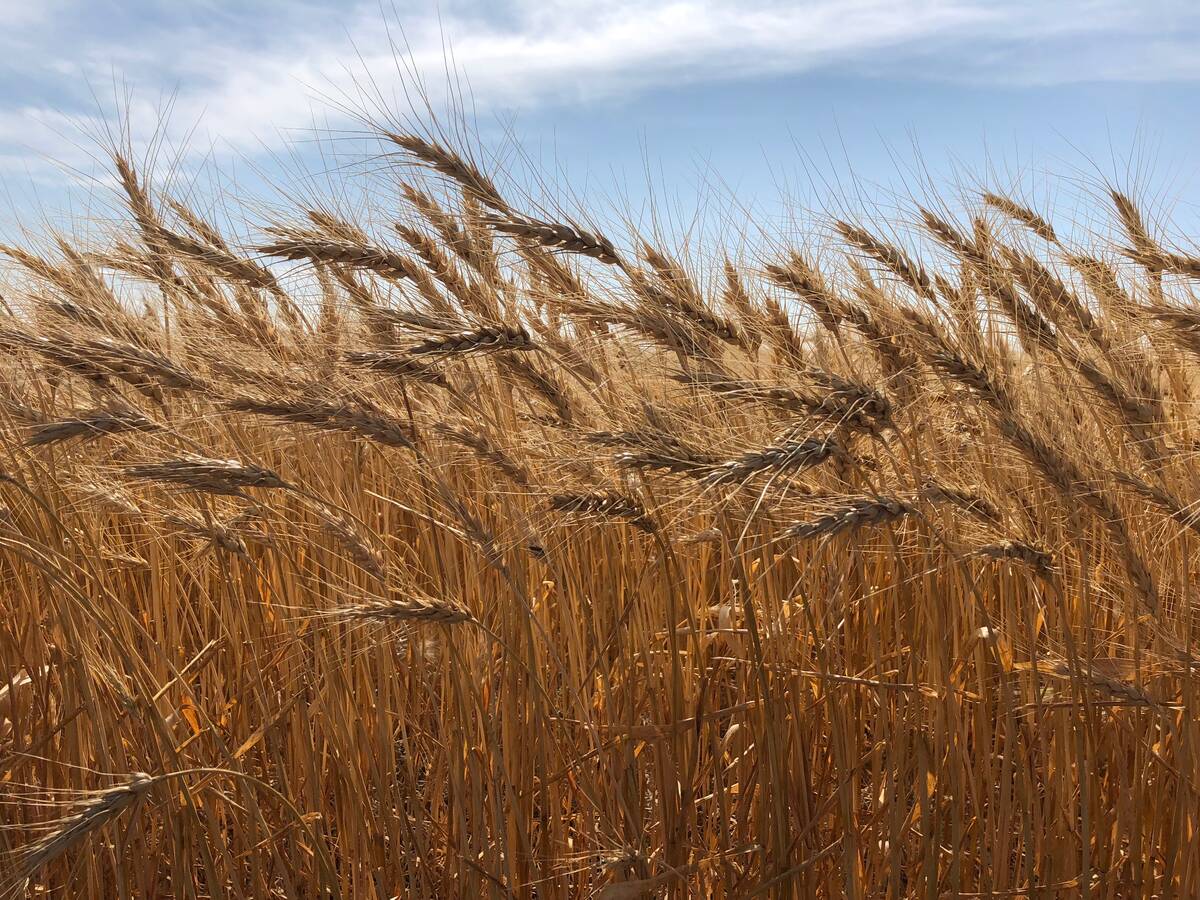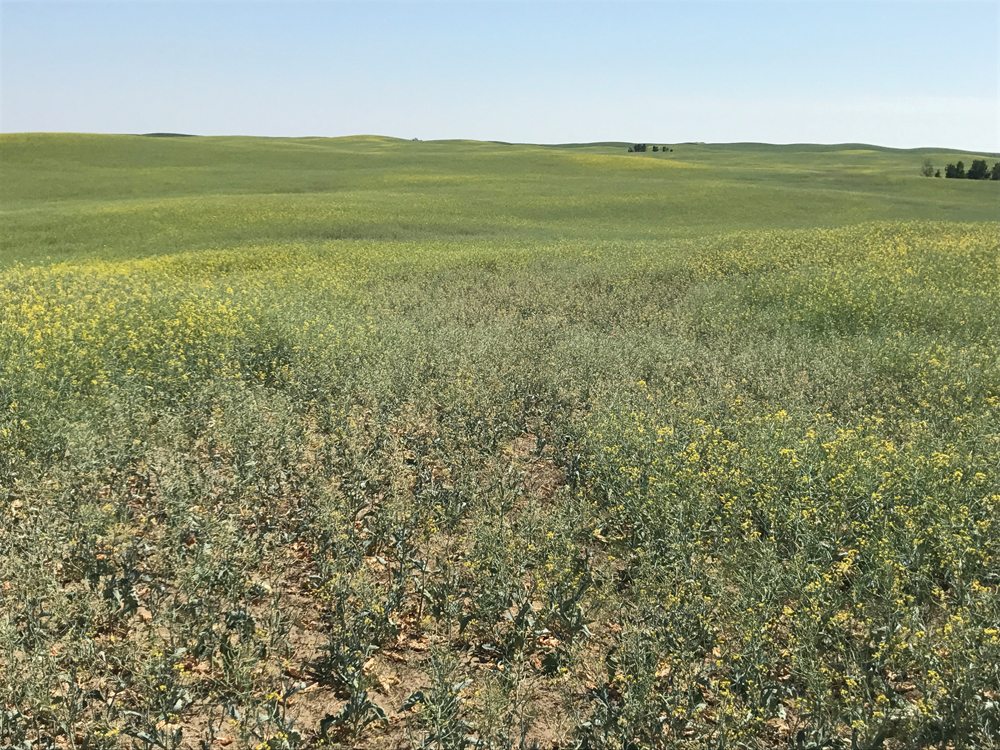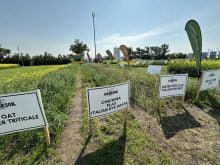
Ted, a Saskatchewan producer who owns a 3,000-acre mixed grain operation near Elrose, asked me to visit his farm last year on July 12. The visit was to assess if diamondback moth larvae populations in his canola field had reached levels necessary to warrant an insecticide application, to save the crop’s yield. Due to lack of rain, the canola plants weren’t thriving and Ted wasn’t sure if applying insecticide would pencil out.
Upon arrival, I noticed the field was a pale, unhealthy-looking colour, indicating the crop was suffering from moisture stress. However, as I approached the field’s entrance, I discovered a bigger problem that needed to be addressed — the crop’s development was uneven and the field contained large, irregular patches of unhealthy plants.
The plants in the unaffected areas were showing typical drought symptoms, such as pale colouring, shorter stature, minimal plant branching, and trace pod abortion throughout.

The flowers were still yellow, and the stems and pods were pale green. There was a small amount of purpling on plant stems. Because it was late afternoon, the plants’ leaves were wilted.
The irregular patches contained stunted, unhealthy-looking plants. The stems, leaves and pods of these plants were turning purple and the leaves were cupping. The plants’ flowers were dried up or aborted.
In addition, the main stems in these damaged areas were half the width of those in the healthier regions, and there was no plant branching.
“Could the canola be turning purple and drying from the drought?” Ted asked. “We need rain bad or this crop will be a write-off.”
Although the crop was experiencing moisture stress throughout the field, this theory didn’t explain why new patches were still forming, or why some patches were more affected than others. There was another issue at work here.

“Could it be drift from a neighbouring field?” Ted asked.
Ted had recently sprayed a Group 2 herbicide on his herbicide-tolerant lentil crop, which was located kitty-corner to the canola field. However, the finger-like areas of damaged plants characteristic of spray drift were absent; in fact, the damaged areas occurred randomly throughout the field. Thus, spray drift, or inversion, was not to blame.
When I examined the field for insect damage, I found diamondback moth larvae populations were well below the economic threshold. Any minimal damage from insect feeding was also consistent throughout the field. At present, there wasn’t any indication of early-season insect feeding, either. In addition, this field was scouted earlier in the season and no diamondback moth populations were found. Therefore, the patches weren’t caused by an insect pest problem.
Read Also

Urea stands tall, production-wise, against ‘alternative’ nitrogen fertilizers
A two-year Alberta project finds old-school granular urea is still the most effective nitrogen fertilizer source for spring wheat yield when compared to “alternative” forms of granular N, at least at the sites studied.
Because I had worked with Ted in the fall, I knew nutrient and micronutrient levels were sufficient for the growth of a healthy canola crop. We had planned a balanced nutrient application based on soil test results, so I concluded the purpling wasn’t due to a sulphur deficiency caused by lack of nutrients. In addition, Ted’s fertilizer application methods were seed-safe.
Soil test results also revealed the field was composed of lighter soils, as well as heavy clay with lower organic matter.
When reviewing this field’s history, Ted revealed a major clue to understanding why the patches were developing in his canola field.
Crop Advisor’s Solution: Healthy soil is productive soil
Interestingly, the pastureland located west of this canola field also had large, irregular patches. Inside those patches, the grasses were shorter in stature and had already set seed. Outside the patches, the plants looked healthy and were still in the vegetative stage.
What piqued my interest in the pastureland was a similar plant response and maturity stage within the patches. Also, the pastureland’s damaged areas began within the line of site of the canola field’s damaged areas.
The soil characteristics of both fields appeared to be similar within and without the patches, which created similar responses in the plants the soil was supporting.
Using satellite imagery allowed me to compare the damaged zones of the canola field with that of the pastureland. GPS data also confirmed my observations on the ground matched those of the aerial maps. The large, irregular patches in Ted’s fields were a result of poor soil quality caused by a specific event.
Several years ago, heavy winds blew topsoil off bare areas of Ted’s fields. The winds deposited topsoil in some areas while removing it from others. This event played a central role in decreasing the land’s soil quality.
The soil located in the damaged areas had low topsoil and organic matter levels, and high compaction; whereas, the soil located outside the patches was richer in organic matter, and had the soil characteristics necessary for better root growth, which permitted access to nutrients and moisture needed for proper plant development.
When I tried to dig into the soil located inside the fields’ patches to examine the plants’ roots, I couldn’t push the shovel into the ground, no matter how hard I tried. The main roots were barely submerged one or two inches below the soil surface, and had grown laterally. Meanwhile, the main roots of plants located outside the damaged areas were three to four inches in length and had secondary branches throughout the soil profile.
Thus, the leaf, stem and pod purpling was caused by phosphorus and sulphur nutrient deficiencies because the plants were moisture stressed and had inadequate root establishment due to poor soil quality.
There was nothing Ted could do that season to help his crop. At harvest, the yield was 25 bushels per acre in the unaffected areas and 15 bushels per acre in the damaged patches. Because the issue stemmed from soil characteristics and environmental events, yield improvement in these fields will involve long-term commitment to soil, fertility and plant management to increase soil quality.
It’s recommended that producers who have soil quality issues manage the stubble in their fields, and always work toward increasing the organic matter on their land where soils are lighter. Organic matter will feed nitrogen back into the soil system. For a healthy, balanced soil system, manage inputs and removals — healthy soil is productive soil.
Additionally, seeding earlier in the spring would allow lighter soils to take advantage of early-season moisture to establish deeper roots.
Finally, the problems producers face in the field aren’t always caused by their actions. It is important to examine past applications and field histories. Producers should look at the big picture, as solutions to agronomic issues may not be where they think they’ll find them.
Dayna Elliott works for Richardson Pioneer Ltd. in Elrose, Sask.














